Ive been using a lacklustre toiletry bag for my sewing kit for about 15 years. I guess it sort of did the trick, but it was lacking in many ways.
I often thought that I should gut the interior and rebuild it. But it always ended up on the back burner.
I jokingly figured I would finish all the other things I wanted to make, finally tackle it ... and then never make anything else.
Figured I would make much more in the years to come and that I owed it to myself to come up with something that really worked.
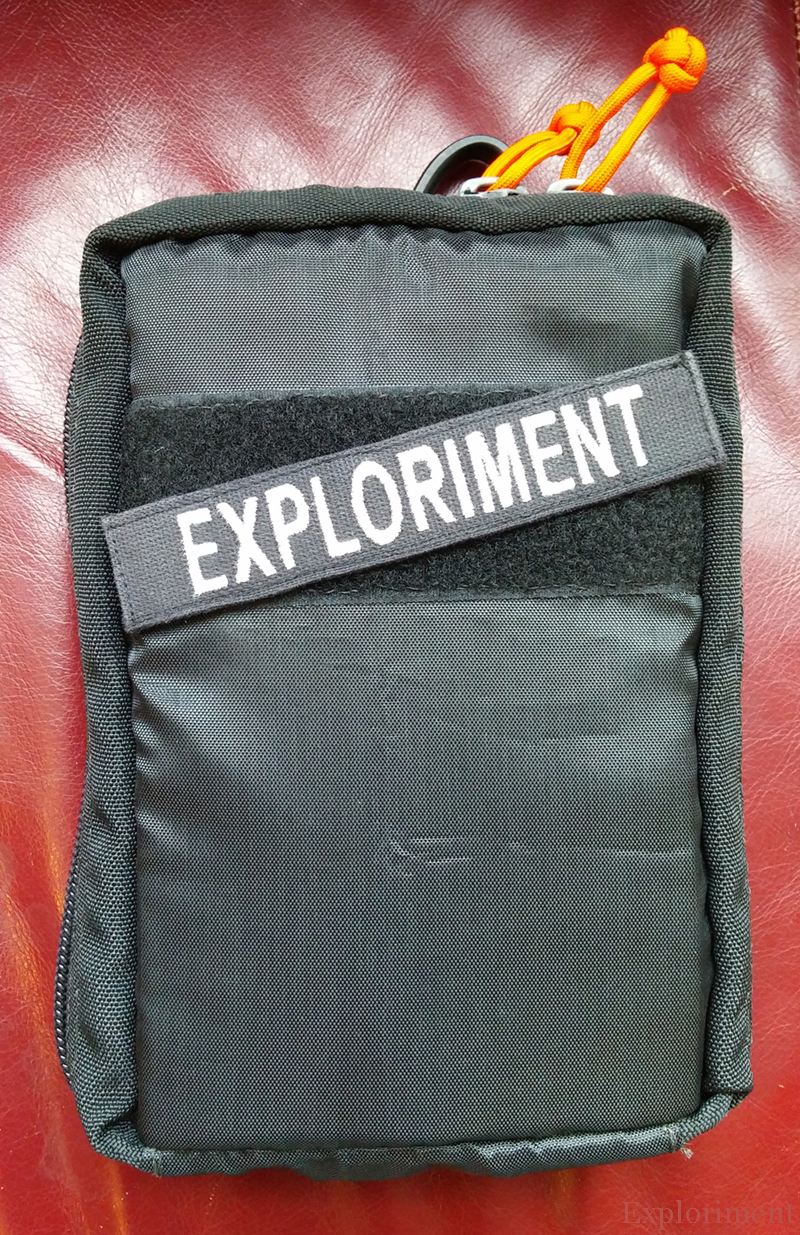
Lets get the most important feature out of the way first: the all important velcro patch panel.
(And my many years doing graphic art taught me that putting type on an angle, automatically makes it more dynamic. )
)
Size wise, its 24 cm (9½") high, 16.5 cm (6½") wide, and 7.5 cm (3") deep.
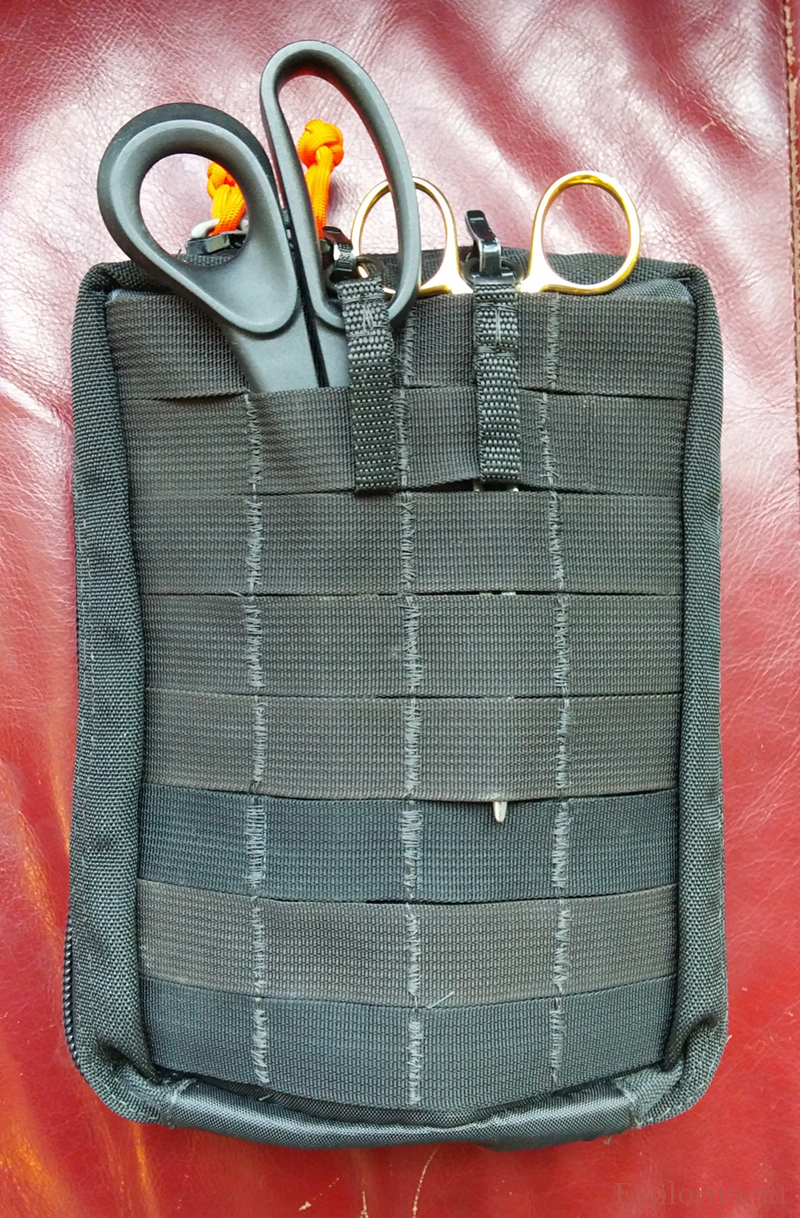
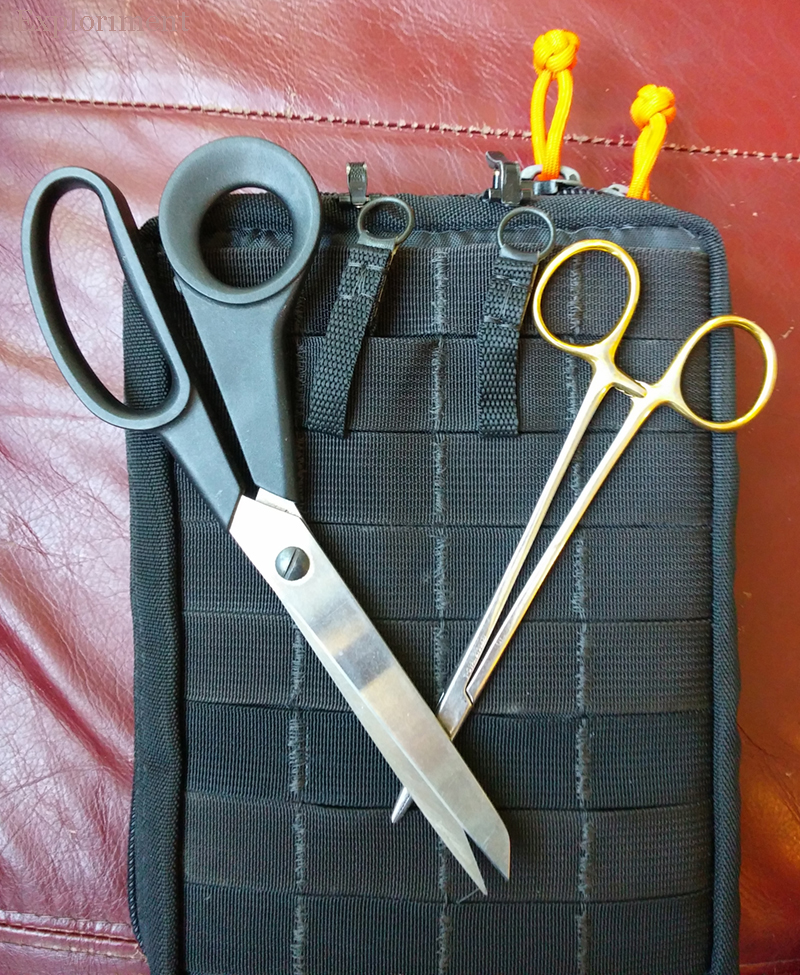
The back features PALS webbing. Partly for attaching to packs and bags, but also to serve as a slot to house a pair of scissors and forceps.
The latter both for pulling a needle, but also to serve as a fid and end grabber for doing paracord work. It can also serve as a clamp to hold things together.

This top view shows the fur coat closure system I use to prevent the two tools from falling out. (Theyre called fur clips {pelzhaken in German}.
Prym makes it, and the product code for it in black is 416502, although it is also available in brown and beige.)
The ring was sewn between the two ends of the ½" webbing, and the metal clasp was sewn to the top of the pouch. Ive done it on a few medical pouches and it works very nicely.
Okay, the outside is a pretty straightforward rectangular pouch. Lets get on to the juicy bits, the interior.

I wanted to be able to open it right up and lay it flat. Yet, if I had it attached to a bag or pack, it could fall open and nothing would fall out.
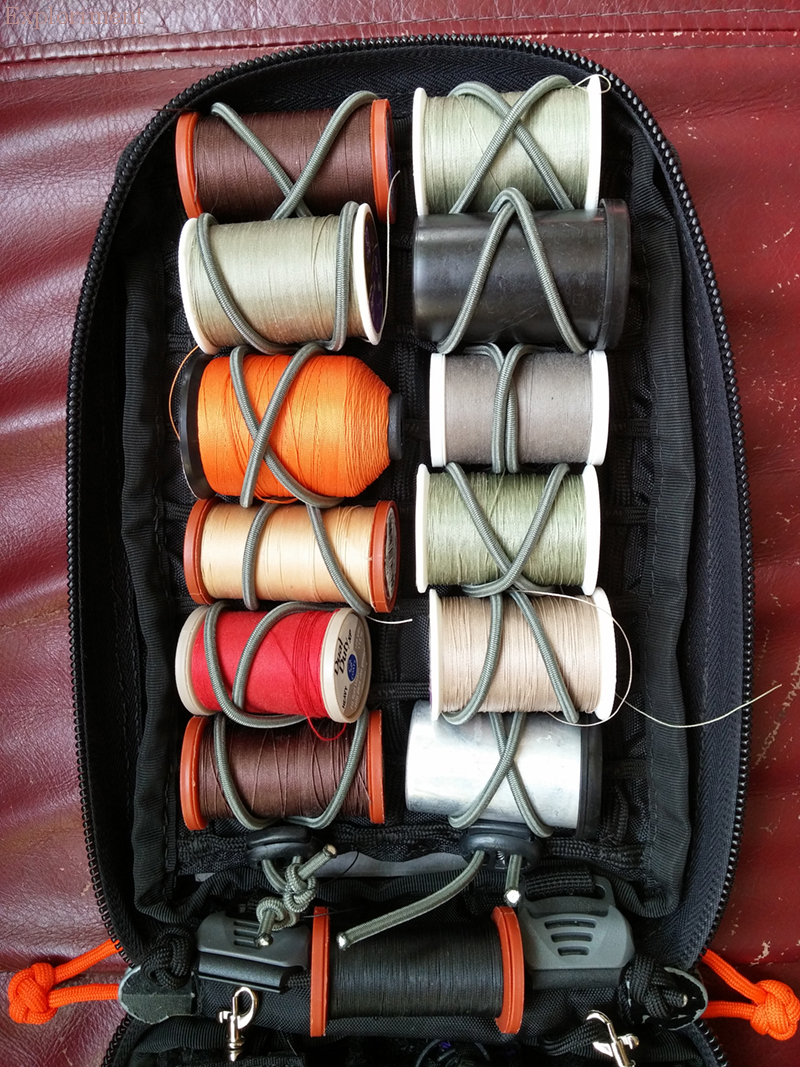
The front panel features CLASP (Cord Lattice Attachment System Pattern), paracord with the cores taken out and sewn in a matrix.
I can attach bunjee cord to this to hold spools of thread (Coats Upholstery for the most part) and film canisters with (rarely used) safety pins, and (often used) rubber thimbles.

(Here you get a view of the CLASP unobstructed.) In the bottom here I attached these ITW-Nexus PipeDoc Sternum Sliders.
And I used them in a completely different way than they were ever intended to be used.
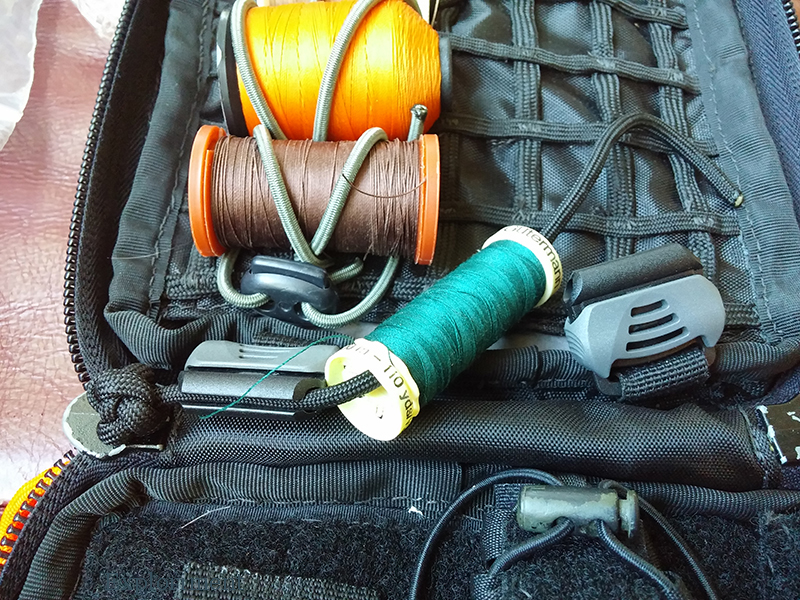
How I intend to use them is as a spindle for a spool of thread. A piece of paracord with a button knot in one end as a stopper.
The bunjee is fine for storing thread, but for the thread that Im using for a given project, and will use for a while usually, I wanted to have easier access to.
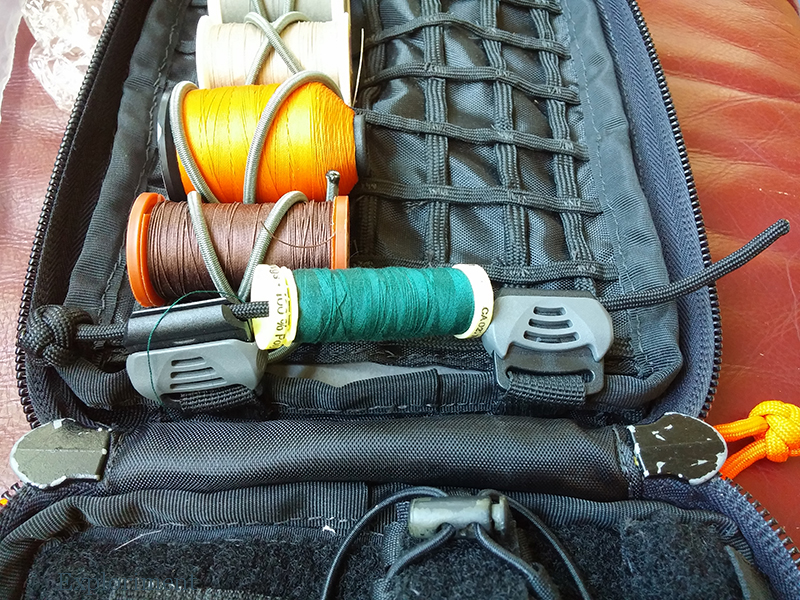
Put the paracord through the spool, slide the paracord through the piping holder...
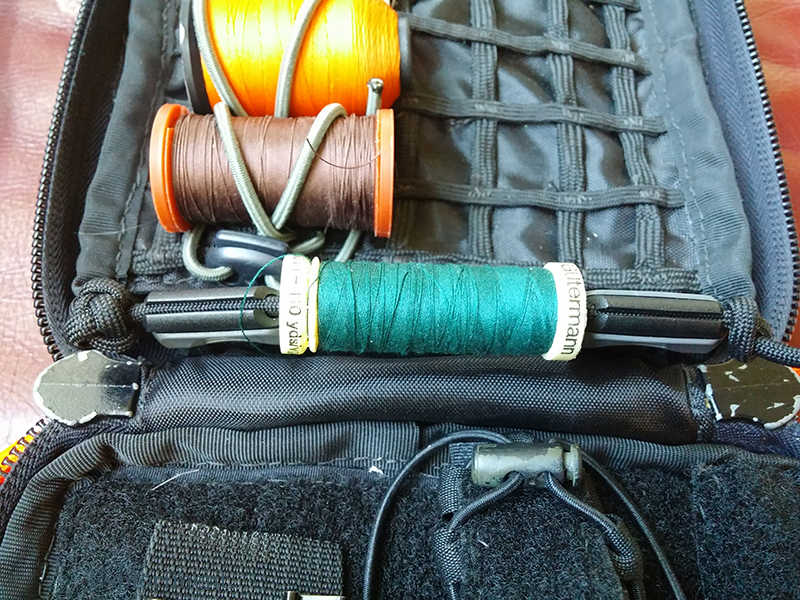
...and finish it off with a figure 8 to serve as a stopper knot on the other end. Works very nicely so far.
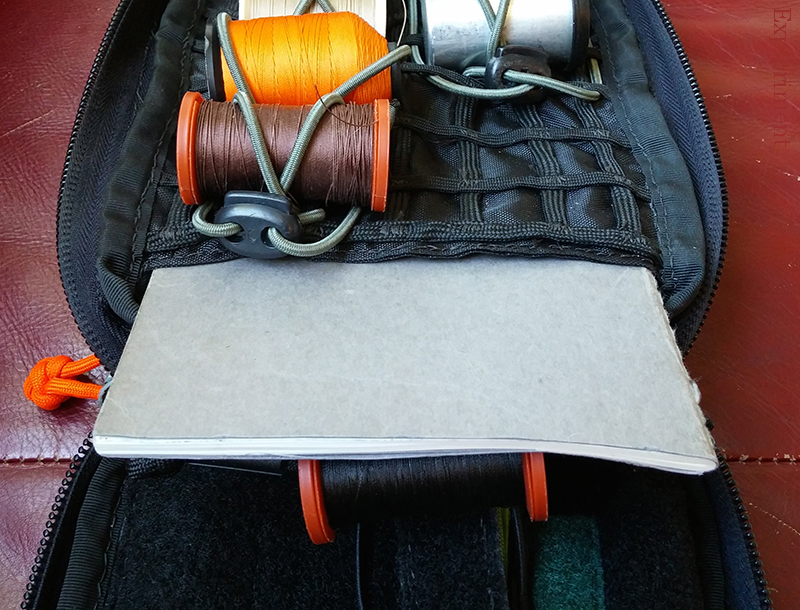
Behind this is a slot to house a sketchbook. I use it for sketching ideas, visually solving problems, scribbling down measurements and calculations, etc.
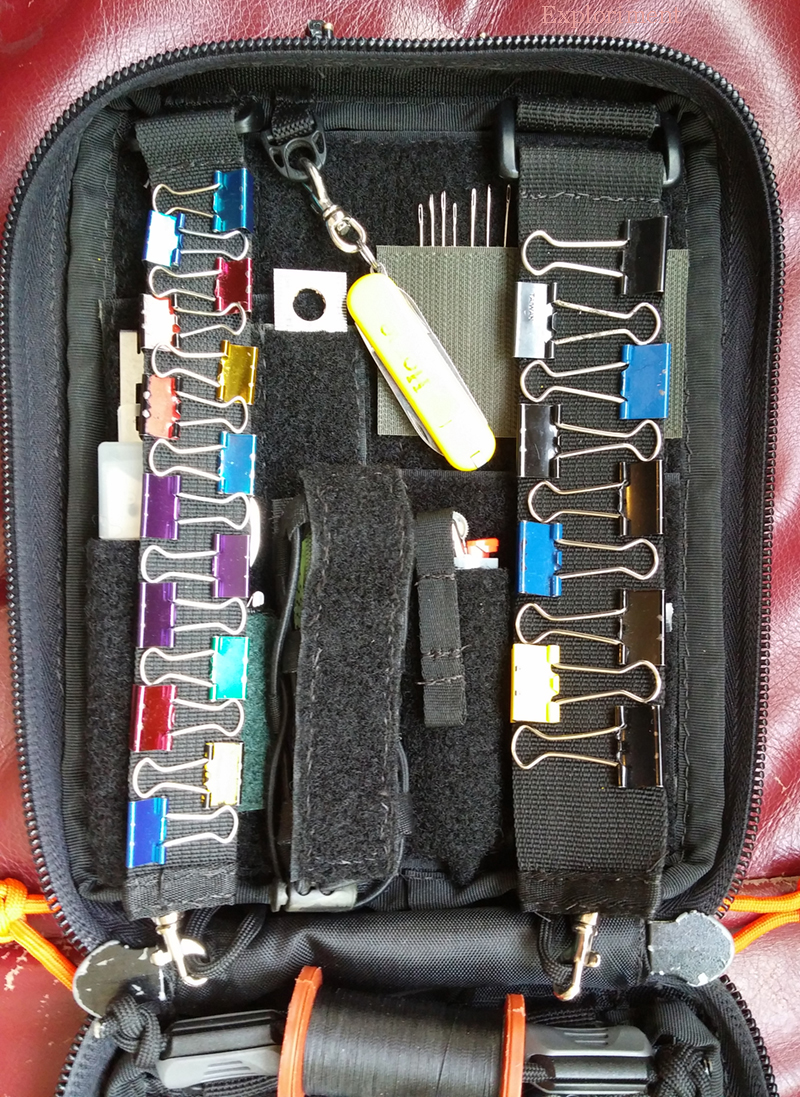
The back panel.
Trying to figure out slots to house all the myriad of tools is a pain in the butt. Not to mention, I might use different tools sometimes for different tasks, purchase different tools that are a different size, etc.
So what I came up with in the Exploriment Laboratories is an exciting new modular attachment system known as VREE Velcro Repositionable Exchangeable Equipment.
(My 4th modular attachment system for anyone keeping count, after Thomas Attachable Bag System, Belt Attachment Lowerable Loop System and Cord Lattice Attachment System Pattern. )
)

Each tool has a pocket made of hook Velcro on the back, and loop Velcro on the front. This way I can position them where I like, remove them, stack them on top of each other, etc.

I still intend to make a few more pockets, but to give you an idea:
Top row: Olfa retractable knife, Dritz measuring gauge, 6" metal ruler, and needles in the loop Velcro with a piece of loop Velcro over that to hold them in place.
(One of the things I still have to make are some pockets for pencil lead holders that I use to hold needles.
But these are the ones I use most frequently, so I thought it made sense to have them be easily accessible.), and while its folded out of the way in this picture, you can see it in the one above, a Victorinox Classic.
Bottom row: extra blades for the Olfa knife, A Staedtler Mars Technico drafting pencil I like these partly because the plunger contains a semi-decent sharpener (will get a second one for which Im trying to find white lead),
Victorinox SwissCard scissors, a measuring tape, bic lighter, candle in a tin, and a white Sakura GellyRoll marker.
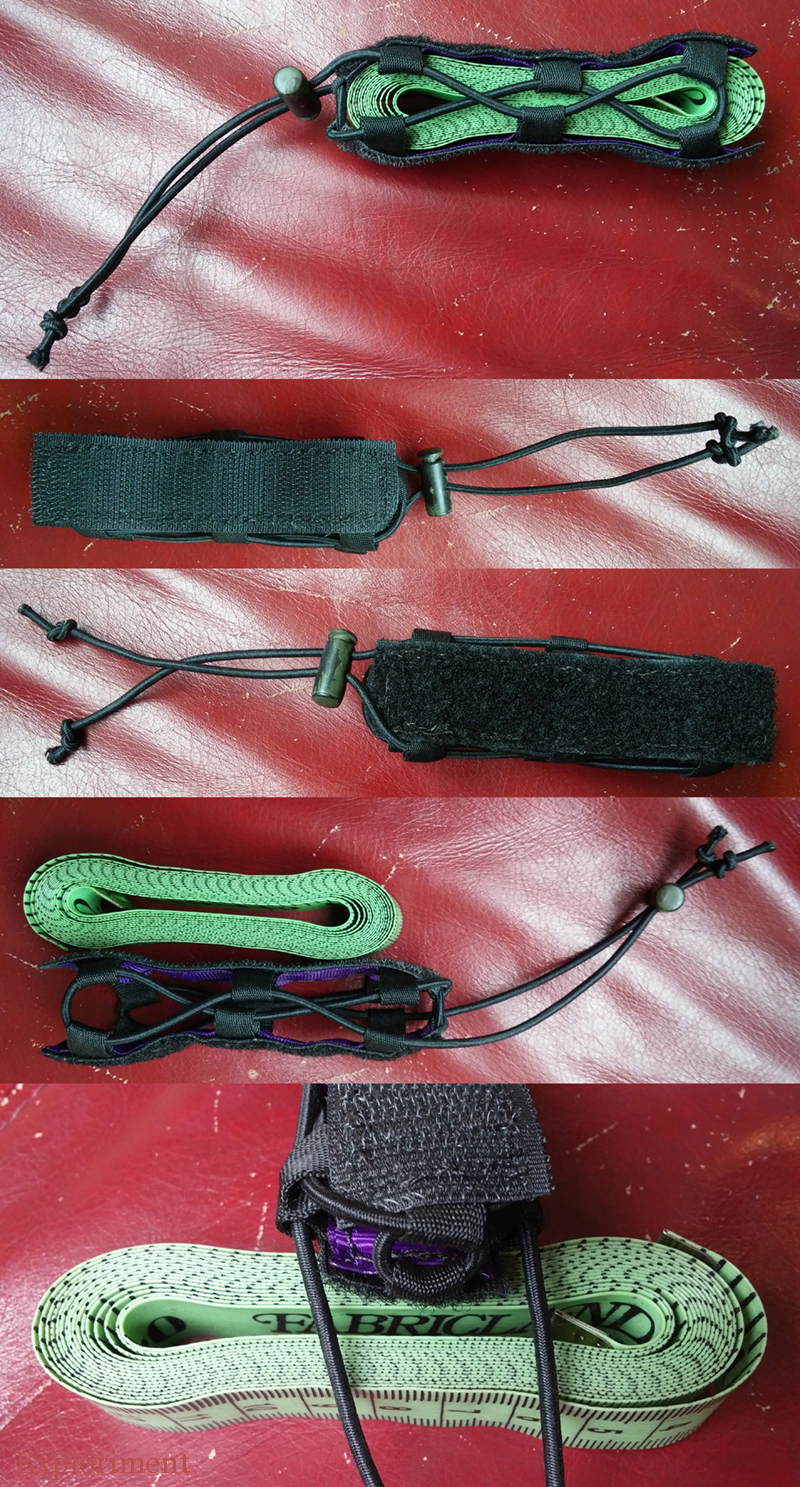
Closeup of the holder for the measuring tape.
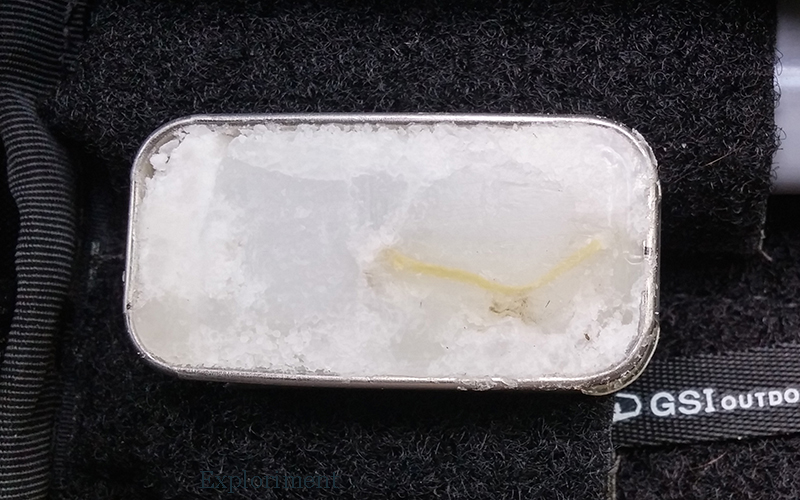
A tea light I pressed into a small tin. If I have to singe the ends of a lot of webbing or material or cord, I prefer to do it with a candle.
Keep a lighter lit for a while and it quickly gets hot enough to burn your thumb. Plus its a waste of the fuel.
I have loads of tea light candles Id prefer to use up before I use up disposable lighters or butane.
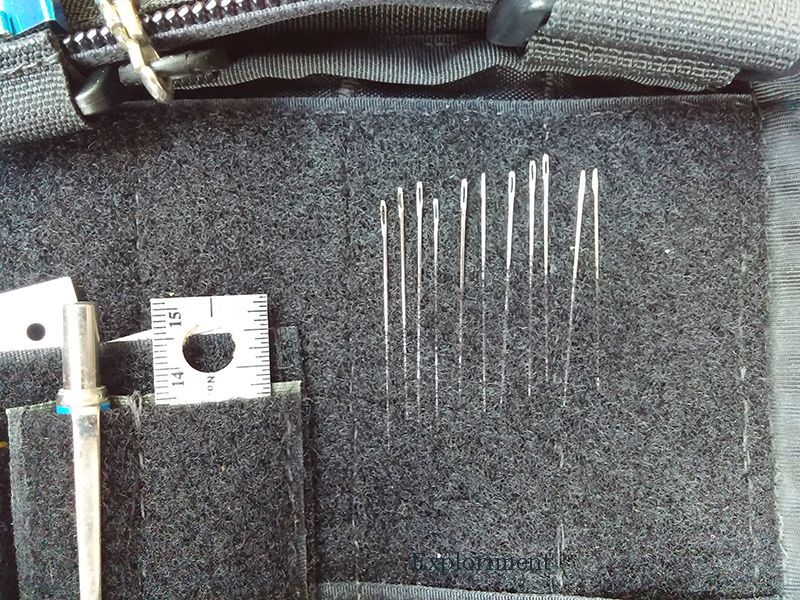
Closeup of the needles in the loop Velcro.

Let me just put this picture up again to show another feature, the Bulldog Tails. I use binder clips a lot. I used to store them in M&M tubes.
When I work on something, as I sew an area, I start removing the bulldog clips. Rather than put them back in the tubes, I would just toss them in the bag, or clip them to things.
Not a great solution. This way I can store them, have easy access both to getting them and also putting them back.
Plus its just more streamlined than the tubes. I can flip them out of the way to get at the tools underneath.
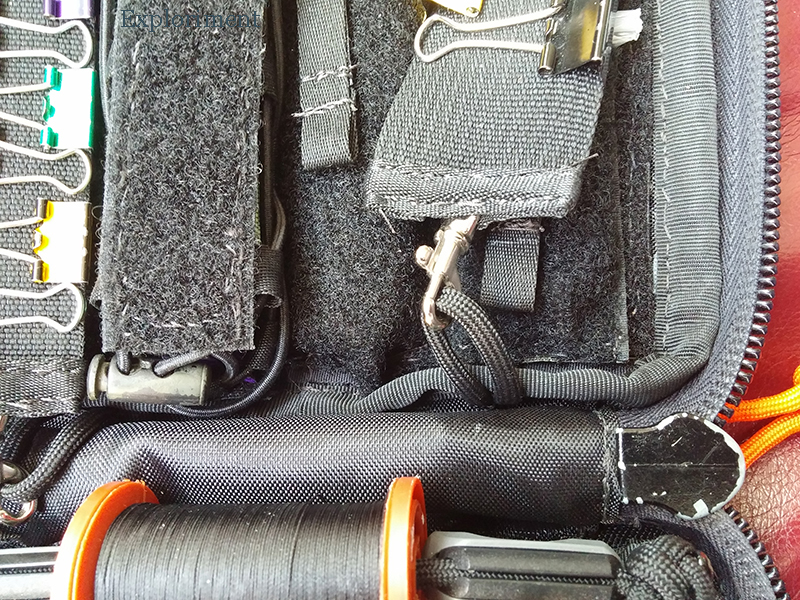
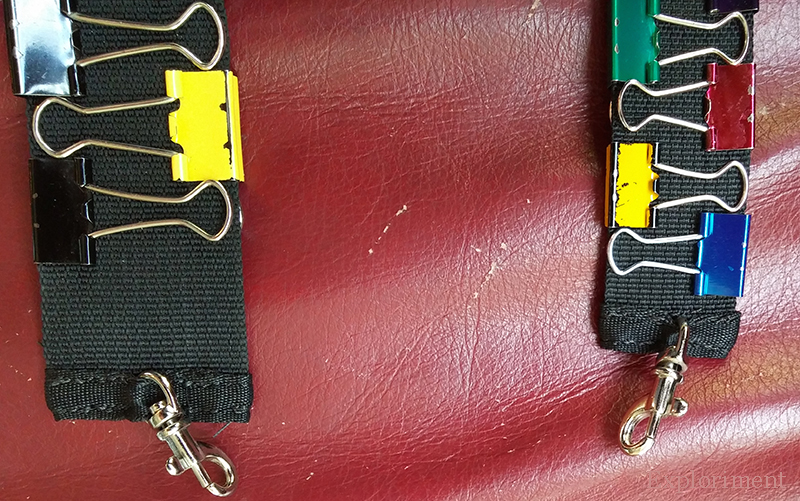
To prevent them flipping and flapping too much, I put clips on the bottom of them, which attach to a loop of paracord.
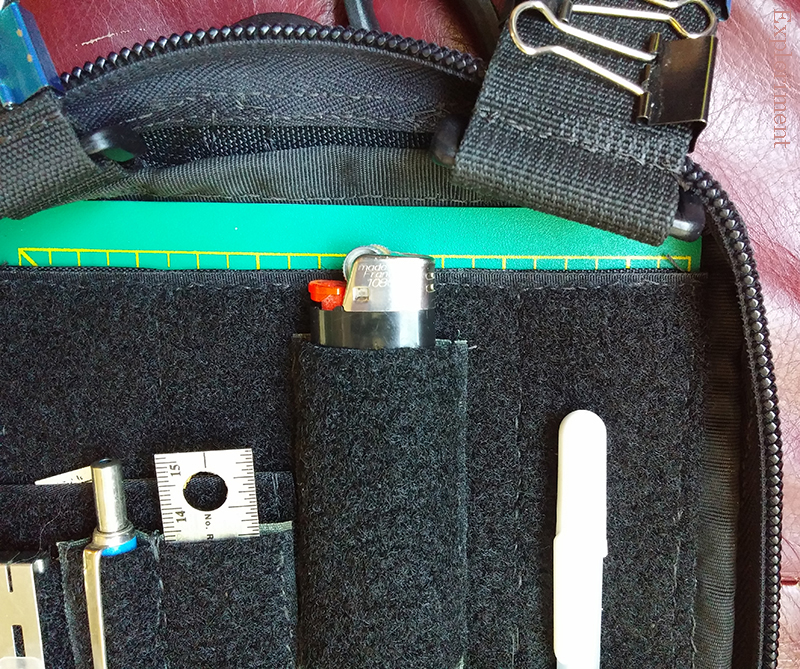
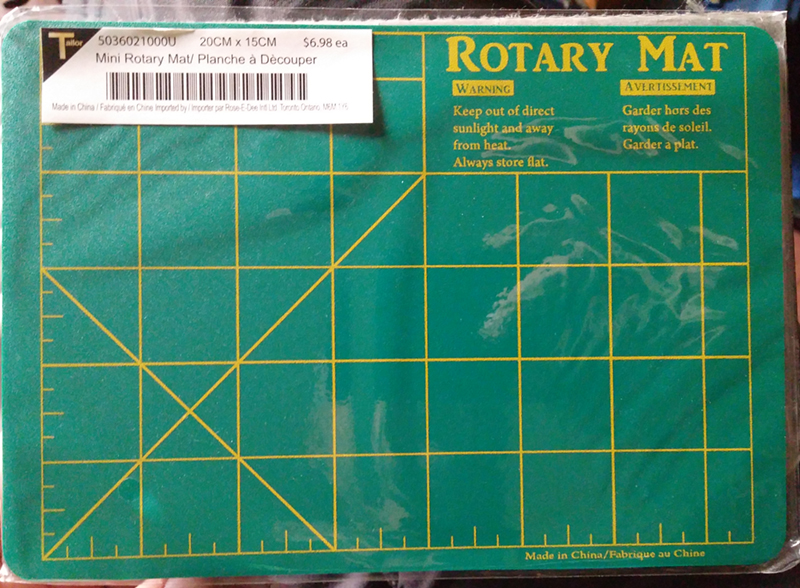
And in a slot pocket behind I have a cutting mat. Not an item Ill use so much, but still really useful to have. And it gives some rigidity to the pouch.
One other thing I intend to add is a flashlight of some sort. Not sure what yet. Maybe a little photon light or a headlamp of some sort. Ill see. Always a handy thing to have.
So there you have it. The Sewmups.
I often thought that I should gut the interior and rebuild it. But it always ended up on the back burner.
I jokingly figured I would finish all the other things I wanted to make, finally tackle it ... and then never make anything else.
Figured I would make much more in the years to come and that I owed it to myself to come up with something that really worked.

Lets get the most important feature out of the way first: the all important velcro patch panel.
(And my many years doing graphic art taught me that putting type on an angle, automatically makes it more dynamic.
Size wise, its 24 cm (9½") high, 16.5 cm (6½") wide, and 7.5 cm (3") deep.


The back features PALS webbing. Partly for attaching to packs and bags, but also to serve as a slot to house a pair of scissors and forceps.
The latter both for pulling a needle, but also to serve as a fid and end grabber for doing paracord work. It can also serve as a clamp to hold things together.

This top view shows the fur coat closure system I use to prevent the two tools from falling out. (Theyre called fur clips {pelzhaken in German}.
Prym makes it, and the product code for it in black is 416502, although it is also available in brown and beige.)
The ring was sewn between the two ends of the ½" webbing, and the metal clasp was sewn to the top of the pouch. Ive done it on a few medical pouches and it works very nicely.
Okay, the outside is a pretty straightforward rectangular pouch. Lets get on to the juicy bits, the interior.

I wanted to be able to open it right up and lay it flat. Yet, if I had it attached to a bag or pack, it could fall open and nothing would fall out.

The front panel features CLASP (Cord Lattice Attachment System Pattern), paracord with the cores taken out and sewn in a matrix.
I can attach bunjee cord to this to hold spools of thread (Coats Upholstery for the most part) and film canisters with (rarely used) safety pins, and (often used) rubber thimbles.

(Here you get a view of the CLASP unobstructed.) In the bottom here I attached these ITW-Nexus PipeDoc Sternum Sliders.
And I used them in a completely different way than they were ever intended to be used.

How I intend to use them is as a spindle for a spool of thread. A piece of paracord with a button knot in one end as a stopper.
The bunjee is fine for storing thread, but for the thread that Im using for a given project, and will use for a while usually, I wanted to have easier access to.

Put the paracord through the spool, slide the paracord through the piping holder...

...and finish it off with a figure 8 to serve as a stopper knot on the other end. Works very nicely so far.

Behind this is a slot to house a sketchbook. I use it for sketching ideas, visually solving problems, scribbling down measurements and calculations, etc.

The back panel.
Trying to figure out slots to house all the myriad of tools is a pain in the butt. Not to mention, I might use different tools sometimes for different tasks, purchase different tools that are a different size, etc.
So what I came up with in the Exploriment Laboratories is an exciting new modular attachment system known as VREE Velcro Repositionable Exchangeable Equipment.
(My 4th modular attachment system for anyone keeping count, after Thomas Attachable Bag System, Belt Attachment Lowerable Loop System and Cord Lattice Attachment System Pattern.

Each tool has a pocket made of hook Velcro on the back, and loop Velcro on the front. This way I can position them where I like, remove them, stack them on top of each other, etc.

I still intend to make a few more pockets, but to give you an idea:
Top row: Olfa retractable knife, Dritz measuring gauge, 6" metal ruler, and needles in the loop Velcro with a piece of loop Velcro over that to hold them in place.
(One of the things I still have to make are some pockets for pencil lead holders that I use to hold needles.
But these are the ones I use most frequently, so I thought it made sense to have them be easily accessible.), and while its folded out of the way in this picture, you can see it in the one above, a Victorinox Classic.
Bottom row: extra blades for the Olfa knife, A Staedtler Mars Technico drafting pencil I like these partly because the plunger contains a semi-decent sharpener (will get a second one for which Im trying to find white lead),
Victorinox SwissCard scissors, a measuring tape, bic lighter, candle in a tin, and a white Sakura GellyRoll marker.

Closeup of the holder for the measuring tape.

A tea light I pressed into a small tin. If I have to singe the ends of a lot of webbing or material or cord, I prefer to do it with a candle.
Keep a lighter lit for a while and it quickly gets hot enough to burn your thumb. Plus its a waste of the fuel.
I have loads of tea light candles Id prefer to use up before I use up disposable lighters or butane.

Closeup of the needles in the loop Velcro.

Let me just put this picture up again to show another feature, the Bulldog Tails. I use binder clips a lot. I used to store them in M&M tubes.
When I work on something, as I sew an area, I start removing the bulldog clips. Rather than put them back in the tubes, I would just toss them in the bag, or clip them to things.
Not a great solution. This way I can store them, have easy access both to getting them and also putting them back.
Plus its just more streamlined than the tubes. I can flip them out of the way to get at the tools underneath.


To prevent them flipping and flapping too much, I put clips on the bottom of them, which attach to a loop of paracord.


And in a slot pocket behind I have a cutting mat. Not an item Ill use so much, but still really useful to have. And it gives some rigidity to the pouch.
One other thing I intend to add is a flashlight of some sort. Not sure what yet. Maybe a little photon light or a headlamp of some sort. Ill see. Always a handy thing to have.
So there you have it. The Sewmups.

